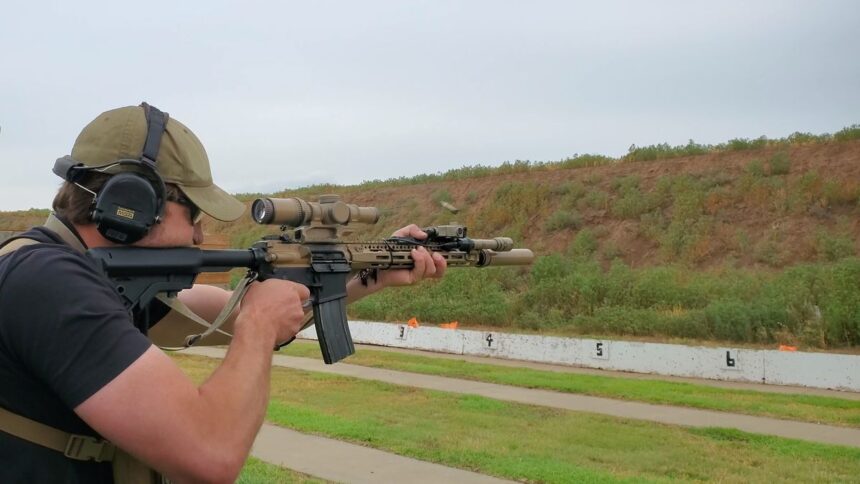Low Power Variable Optics (LPVOs) are rapidly gaining popularity in law enforcement circles, replacing traditional red dot sights and fixed-power scopes on patrol rifles. With their ability to provide both quick target acquisition at low magnifications and precision shooting at higher zoom levels, LPVOs offer significant advantages for police officers in tactical scenarios. In this guide, we’ll explore why police departments are making the switch to LPVOs, their benefits for law enforcement, and the best LPVOs for duty use.
What Is an LPVO Scope?
An LPVO (Low Power Variable Optic) is a type of rifle scope that offers an adjustable magnification range, typically from 1x to 4x, 6x, 8x, or even 10x. Unlike fixed magnification sights, LPVOs allow officers to switch seamlessly between close-quarters engagement and longer-range precision shots.
Why Law Enforcement Is Adopting LPVOs
Several factors are driving the adoption of LPVOs in police forces across the country. The main advantages include:
- Increased Versatility
A key reason officers are switching to LPVOs is their adaptability. At 1x magnification, they function similarly to a red dot sight, providing quick target acquisition for close-quarters engagements. When increased precision is needed, officers can quickly dial up the magnification to engage threats at greater distances.
- Improved Target Identification
In law enforcement, identifying threats accurately is crucial. LPVOs provide better clarity and magnification than standard red dot sights, allowing officers to distinguish between armed suspects and bystanders more effectively. This can help reduce the risk of misidentification and unnecessary use of force.
- Better Engagement at Distance
Unlike traditional red dot sights, LPVOs provide magnification that enhances an officer’s ability to engage threats beyond 50-100 yards. This is particularly useful in active shooter situations, rural patrols, or operations in open terrain.
- Illuminated Reticles for Low-Light Use
Many LPVOs come equipped with illuminated reticles, improving visibility in low-light conditions. Whether patrolling at night or working in dimly lit buildings, officers can maintain accuracy in various lighting environments.
- Enhanced Accuracy Under Stress
The combination of magnification, improved field of view, and precise reticles allows officers to make more accurate shots under high-stress conditions. This is essential for reducing collateral damage and ensuring officer safety.
LPVO vs. Traditional Tactical Scopes
Police departments previously relied on red dot sights, holographic sights, or fixed magnification scopes for duty rifles. Here’s how LPVOs compare:
| Feature | LPVO | Red Dot Sight | Fixed Magnification Scope |
| Magnification Range | 1-4x, 1-6x, 1-8x, 1-10x | 1x only | 3x, 4x, 5x |
| Best for Close-Range | Yes (at 1x) | Yes | No |
| Best for Long-Range | Yes | No | Yes |
| Target Identification | Excellent | Limited | Good |
| Low-Light Performance | Good with illuminated reticle | Fair | Moderate |
| Weight & Size | Moderate | Light | Heavy |
Best LPVOs for Police Use
When selecting an LPVO for law enforcement, factors such as durability, optical clarity, reticle type, and ease of use are critical. Here are some of the best options for patrol and duty rifles:
- Vortex Razor HD Gen III 1-10×24
- Exceptional glass clarity and resolution
- True 1x magnification for close-range shooting
- Durable, shockproof construction
- Red or green illuminated reticle options
- Trijicon VCOG 1-6×24
- Combat-proven ruggedness
- First focal plane (FFP) reticle for better ranging
- Long battery life with LED illumination
- Waterproof and shockproof
- Leupold Mark 6 1-6×20
- Lightweight and compact design
- Outstanding low-light performance
- Military-grade durability
- Rapid-adjust magnification lever
- Primary Arms PLxC 1-8×24
- Advanced ACSS reticle for law enforcement applications
- Crystal-clear glass for target identification
- First focal plane design for better ranging at high magnification
- Budget-friendly compared to premium brands
How to Use an LPVO on a Patrol Rifle
Switching to an LPVO requires some adjustments in training and tactics. Here are key considerations for officers:
- Mastering Magnification Adjustments
Officers must train to quickly adjust their LPVO from 1x to higher magnifications depending on the situation. A throw lever can assist with rapid changes.
- Understanding the Reticle
Most LPVOs have Bullet Drop Compensation (BDC) reticles or MIL/MOA markings for range estimation. Officers should familiarize themselves with holdovers to make accurate shots at different distances.
- Proper Mounting and Zeroing
LPVOs should be securely mounted using high-quality mounts to maintain zero under recoil. A 50/200-yard zero is often recommended for law enforcement use.
- Training for CQB and Long-Range Engagements
Regular training exercises should incorporate both close-quarters and extended-range shooting drills to maximize the benefits of an LPVO.
- Battery and Illumination Management
While many LPVOs have long battery life, officers should routinely check battery levels for illuminated reticles to ensure visibility in low-light environments.
Common Misconceptions About LPVOs for Law Enforcement
- “LPVOs Are Too Slow for CQB”
Modern LPVOs offer a true 1x setting, making them nearly as fast as red dot sights for close-quarters engagements.
- “They’re Too Heavy”
While LPVOs add some weight compared to red dots, lightweight models and proper rifle balancing mitigate this issue.
- “They’re Too Expensive”
High-quality LPVOs are an investment, but budget-friendly options exist, and the benefits in accuracy and versatility outweigh the cost.
Conclusion
LPVOs are becoming the optic of choice for law enforcement officers due to their versatility, accuracy, and ability to perform well in both CQB and long-range engagements. With the right training and equipment, police officers can maximize the effectiveness of LPVOs on their patrol rifles, improving both officer safety and operational effectiveness. As more agencies make the switch, LPVOs are proving to be an invaluable tool for modern law enforcement.






